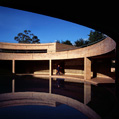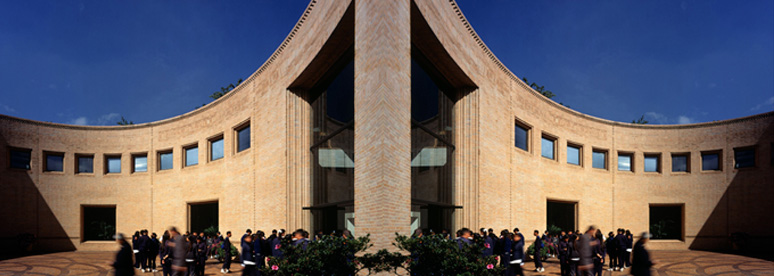PAST EXHIBITION

Open Spaces / Collective Spaces
An exhibit featuring the work of Colombian architect Rogelio Salmona
July 23, 2009 – September 30, 2009
ABOUT THE EXHIBIT
The Art Museum of the Americas announces the opening of Rogelio Salmona: open spaces / collective spaces, the first U.S.exhibition devoted entirely to the work of celebrated Colombian architect Rogelio Salmona (1929‐2007) in its first traveling stop in North America.
For fifty years, Salmona was a key figure in the intellectual life of Colombia and Latin America and was part of a group of architects who, in reaction to the ubiquitous nature of international modernism, favored architecture designed with location, landscape and topography in mind.
He was honored with numerous awards and distinctions such as the Colombian National Architecture Prize (1986, 1988, and 1990), the Architect of the Americas Award (1999), the Taller América Award (Santiago de Chile School of Architects) (1990), the America Award from the Latin American Architecture Seminar (Brazil) (1995), the Prince Claus Award (Netherlands) (1998), the American Architect Award (Pan‐American Federation of Architects’ Associations, Costa Rica) (1999), and the Alvar Aalto Medal (2003) ‐‐an award given in recognition of a significant contribution to creative architecture; and a year before his death, in 2006, Salmona was appointed Honorary Fellow of The American Institute of Architects. In spite of the recognition his architectural oeuvre has achieved, to date there had not been an exhibition dedicated to Salmona’s work in the U.S. until now.
Rogelio Salmona was born in Paris in 1929, and moved to Bogotá with his family at age two. In 1946 he entered the Universidad Nacional’s School of Architecture and was introduced to Le Corbusier during the architect’s visit to Bogotá in 1947. He then joined Le Corbusier’s studio from 1948 to 1956 and collaborated on many projects during this period, among them the Roq et Rob residential project, the Master Plan for the city of Bogotá, the Chandigarh design in India and the Jaoul houses. He attended Pierre Francastel’s Sociology of Art classes at the Sorbonne’s École des Hautes Études Sociales. In 1959, Salmona returned to Bogotá and taught History of Architecture at the Universidad de los Andes and participated in a variety of design workshops.
Some of Salmona´s most notable works include the National Archives Building (Bogotá), the Virgilio Barco Public Library (Bogotá), the Quimbaya Museum (Armenia), the Museum of Modern Art (Bogotá), and the Presidential Guest House (Cartagena). Most recently he completed the Gabriel Garcia Márquez Cultural Center in the heart of Bogotá. Throughout his career he built large‐scale urban housing projects in various cities as well as numerous houses and apartment buildings. He designed the Polo Club residential units with Guillermo Bermúdez in 1960, and in 1963 earned his diploma in architecture from the Universidad de los Andes after presenting the Los Cerros Cooperative Housing project as his thesis. He helped design the 2,000‐unit Timiza housing development in Bogotá in 1964, and for the next several years developed the Torres del Parque residences and designed several private homes.
The Art Museum of the Americas’ show Rogelio Salmona: open spaces / collective spaces explores five major themes of Salmona’s work. Urban Counter/ Proposals illustrates the relationship of architecture, the city and public space; Trace and Memory highlights his sense of and use of history; Composition, Path and Surprise explores the sensorial and process of discovery of his architectural spaces; Topographies explores his adaptation to and/or creation of the terrain and roofscapes. Extending the boundary examines his exploration of other materials in addition to brick in his last projects. Salmona's use of brick is also a sub‐theme of the exhibition. The interview with the architect, which accompanies the exhibition, highlights and answers questions regarding the five themes of the exhibition and the curatorial vision.
Rogelio Salmona: open spaces / collective spaces includes scale models designed for the exhibition, original sketches and drawings, five 10‐minute films interspersed throughout the exhibition, black and white period photographs as well as new ones, aerial footage, and panoramic cylinders suspended from the ceiling that capture the sensation of being inside Salmona’s spaces. A complete and definitive chronology of all of Salmona's projects serves as an index since the exhibit is organized by themes and not chronologically. The exhibition also includes a satellite map of Bogotá that locates all the buildings and projects, and a biography with his travel sketchbooks and photographs from his personal collection. Rogelio Salmona: open spaces / collective spaces was inaugurated in April 2006 in Bogotá, Colombia, and has since traveled to Seville, Lisbon, Madrid, Helsinki (Museum of Finnish Architecture), Paris (Cité d'Architecture et du Patrimoine) Rome (Casa della Architettura), Mexico (Guadalajara), Santiago de Chile (Palacio de Bellas Artes), Buenos Aires (Centro Cultural de La Recoleta), Japan (Taisei Gallerie) and Seoul (Korea Foundation).
FEATURED ARTIST
Rogelio Salmona

